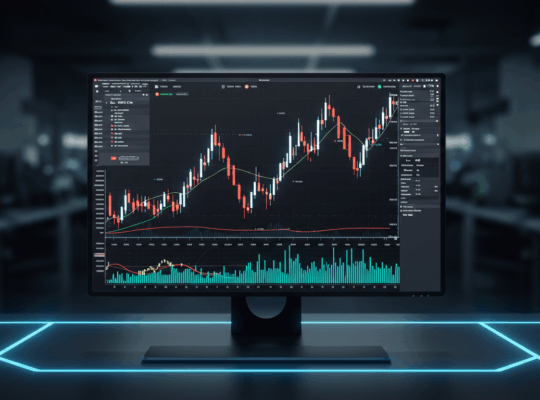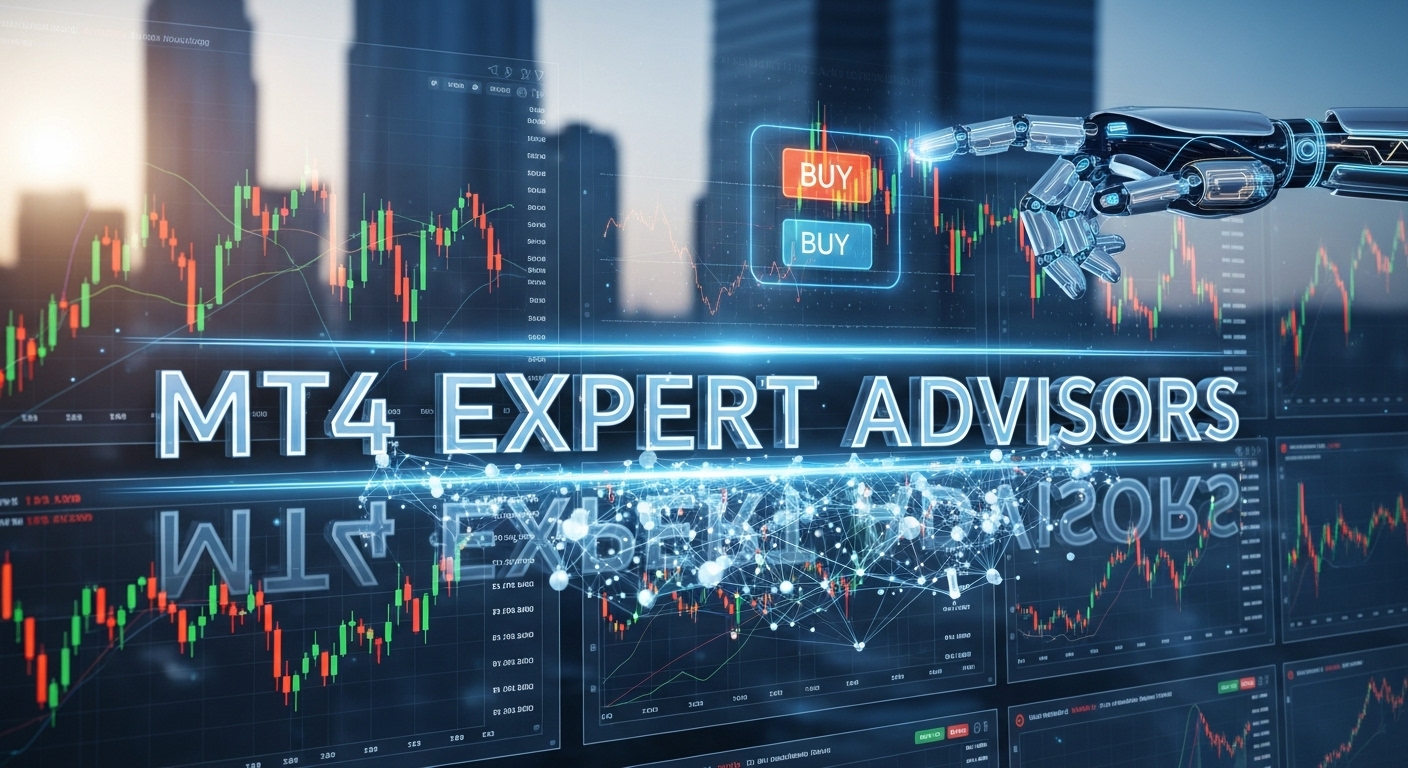Recent industry data shows that over 75% of forex trading volume now comes from algorithmic and automated systems, with retail traders increasingly adopting Expert Advisors to level the playing field. Whether you’re a busy professional who can’t watch charts all day, a systematic trader looking to remove emotions from your decisions, or someone curious about the potential of automated trading, understanding MT4 Expert Advisors could be the game-changer you’ve been searching for.
In this comprehensive guide, we’ll explore everything you need to know about MT4 Expert Advisors – from understanding what they are and how they work to installing, configuring, and optimizing them for your trading goals. You’ll discover the different types available, learn how to evaluate their performance, and understand both the tremendous opportunities and potential pitfalls of automated forex trading.
What Are MT4 Expert Advisors and How Do They Work?

MT4 Expert Advisors are automated trading programs designed to operate within the MetaTrader 4 platform, executing trades based on predetermined algorithms and market conditions. Think of them as your personal trading assistant that never gets tired, never experiences fear or greed, and can monitor multiple currency pairs simultaneously while you focus on other aspects of your life or trading business.
At their core, Expert Advisors are sophisticated pieces of software written in MQL4 (MetaQuotes Language 4), the proprietary programming language designed specifically for the MetaTrader platform. These programs analyze real-time market data, apply complex mathematical calculations, and make trading decisions based on the specific rules and parameters you’ve defined or that come pre-programmed by their developers.
The beauty of MT4 Expert Advisors lies in their ability to process vast amounts of market information in milliseconds. While a human trader might spend several minutes analyzing a single chart setup, an EA can simultaneously evaluate dozens of currency pairs, identify trading opportunities, calculate position sizes, set stop losses and take profits, and execute trades – all in the time it takes you to blink.
Expert Advisors operate by continuously monitoring price movements, technical indicators, and market conditions. When specific criteria are met – such as a moving average crossover, a break of support or resistance, or a particular candlestick pattern – the EA springs into action. It can open new positions, modify existing ones, or close trades based on its programmed logic. This systematic approach eliminates the emotional component of trading, which is often cited as one of the primary reasons why many manual traders struggle to achieve consistent profitability.
The integration between Expert Advisors and the MT4 platform is seamless. Once installed and configured, EAs appear in the Navigator panel of your trading terminal, ready to be attached to any chart. They can access all the same market data, indicators, and trading functions that manual traders use, but they do so with unwavering consistency and lightning-fast execution speed.
What sets quality Expert Advisors apart is their ability to adapt to changing market conditions. Advanced EAs incorporate multiple layers of logic, allowing them to adjust their strategies based on factors like market volatility, time of day, economic news releases, or overall market sentiment. Some even include machine learning capabilities, enabling them to improve their performance over time by learning from past trades and market patterns.
The Compelling Benefits of Automated Trading with Expert Advisors
The transition from manual to automated trading represents one of the most significant evolutionary steps a trader can take, and the benefits of using MT4 Expert Advisors extend far beyond simple convenience. Understanding these advantages can help you appreciate why automated trading has become such a dominant force in the forex market.
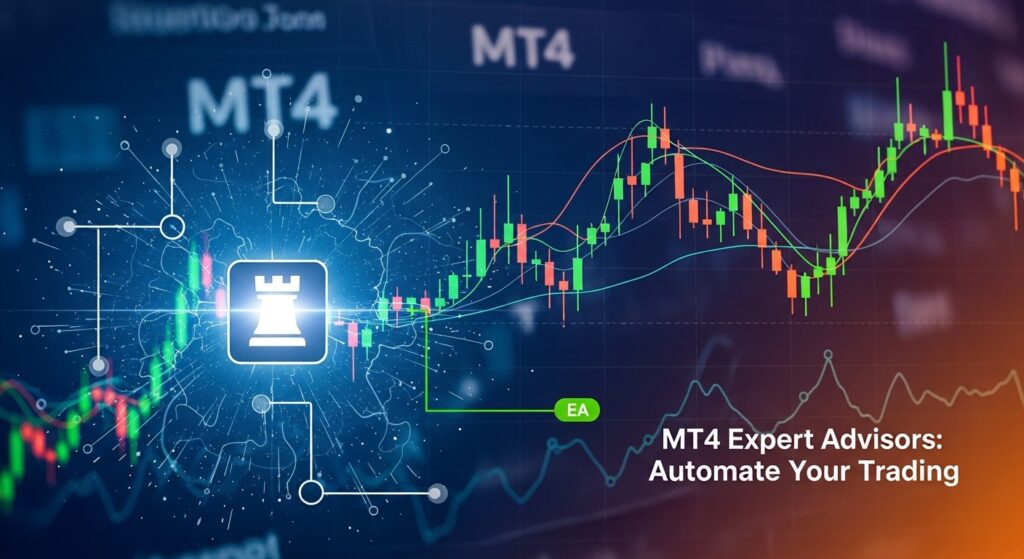
Perhaps the most obvious benefit is the elimination of emotional trading decisions. Fear and greed are the two emotions that destroy more trading accounts than any technical analysis mistake or market knowledge gap. When you’re manually trading and see a position moving against you, the temptation to hold on “just a little longer” can be overwhelming. Conversely, when a trade is profitable, the fear of giving back gains might cause you to exit prematurely. Expert Advisors remove these emotional obstacles entirely, executing trades based purely on logic and predetermined criteria.
The 24/7 market monitoring capability of Expert Advisors represents another transformative advantage. The forex market operates across multiple time zones, with significant trading sessions in Sydney, Tokyo, London, and New York. Major market moves can happen at any time, and missing a key breakout because you were sleeping or at work can be frustrating and costly. Expert Advisors never sleep, never take breaks, and never miss an opportunity that meets their programmed criteria.
Speed of execution is crucial in forex trading, where prices can change in fractions of a second. Human reaction times, even for experienced traders, typically range from several hundred milliseconds to several seconds. In fast-moving markets, this delay can mean the difference between catching a profitable move and missing it entirely. Expert Advisors can analyze market conditions and execute trades in milliseconds, ensuring you capture opportunities at the optimal price points.
The consistency factor cannot be overstated. Every trader has experienced the frustration of deviating from their trading plan, whether due to overconfidence after a winning streak or fear after a series of losses. Expert Advisors follow their programmed strategy with unwavering discipline, applying the same risk management rules and trade selection criteria to every opportunity. This consistency is essential for long-term profitability and helps ensure that your actual results align with your backtested expectations.
Risk management becomes more precise and reliable with Expert Advisors. Manual traders often struggle with position sizing, sometimes risking too much on high-confidence trades or too little on quality setups. EAs can incorporate sophisticated risk management algorithms that automatically calculate optimal position sizes based on factors like account balance, volatility, and correlation between different currency pairs. They can also implement advanced techniques like trailing stops, break-even stops, and partial profit-taking that require constant monitoring when done manually.
The ability to trade multiple strategies simultaneously is another significant advantage. A skilled manual trader might effectively monitor two or three currency pairs at once, but Expert Advisors can handle dozens of pairs across multiple timeframes without any degradation in performance. This diversification capability allows you to spread risk across different markets and trading approaches, potentially improving your overall risk-adjusted returns.
Installing and Configuring Your First MT4 Expert Advisor
Getting started with MT4 Expert Advisors might seem technical, but the process is actually quite straightforward once you understand the basic steps. The key is to approach installation methodically and test everything thoroughly before risking real money.
The first step in your Expert Advisor journey begins with obtaining the EA files themselves. Expert Advisors come in two primary file formats: .ex4 files, which are compiled and ready to use, and .mq4 files, which contain the source code and need to be compiled within MetaTrader 4. Most commercial EAs are distributed as .ex4 files to protect the developer’s intellectual property, while free or open-source EAs often come as .mq4 files that you can examine and modify if you have programming skills.
Once you’ve downloaded your chosen Expert Advisor, the installation process involves navigating to the correct folder within your MT4 installation directory. Open your MetaTrader 4 platform and go to File > Open Data Folder. This will open Windows Explorer to your MT4 data directory. From here, navigate to the MQL4 folder, then to the Experts subfolder. This is where all Expert Advisor files must be placed for MT4 to recognize them.
After copying your EA files to the Experts folder, return to your MetaTrader 4 platform and refresh the Navigator panel. You can do this by right-clicking in the Navigator area and selecting “Refresh,” or simply restarting MT4. Your newly installed Expert Advisor should now appear in the Expert Advisors section of the Navigator panel.
Before attaching your EA to a chart, there’s a crucial step that many new users overlook: enabling automated trading. Look for the “Auto Trading” button in your MT4 toolbar – it should show a green light when active. If it’s red or gray, click it to enable automated trading. Without this setting enabled, your Expert Advisor will not be able to execute trades, regardless of how perfectly it’s configured.
The configuration process begins when you drag your Expert Advisor from the Navigator onto a chart of the currency pair you want to trade. This action opens the Expert Advisor properties dialog, where you’ll encounter several important tabs. The Common tab contains general settings like enabling automated trading for this specific EA, allowing DLL imports if required, and setting permissions for the EA to trade.
The Inputs tab is where the real customization happens. Here you’ll find all the parameters that control how your Expert Advisor operates. These might include settings for lot size, stop loss and take profit levels, trading hours, maximum spread tolerance, and strategy-specific parameters like moving average periods or breakout thresholds. Take time to understand each parameter – many EAs come with documentation explaining what each setting does and recommended values for different account sizes and risk tolerances.
Risk management settings deserve special attention during configuration. Never simply accept default lot sizes or risk parameters without considering your account balance and risk tolerance. A common mistake is using fixed lot sizes that may be appropriate for a $10,000 account on a $1,000 account, leading to excessive risk. Look for EAs that offer percentage-based position sizing or that allow you to specify maximum risk per trade as a percentage of your account balance.
Testing your configuration on a demo account is absolutely essential before going live. Even if you’re using a well-established Expert Advisor with proven results, your specific broker’s spreads, execution speed, and trading conditions may affect performance. Attach your EA to a demo account and let it run for at least several days, preferably during different market conditions, to ensure it’s operating as expected.
Understanding Different Types of Expert Advisors
The world of MT4 Expert Advisors is incredibly diverse, with different types designed to exploit various market conditions and trading opportunities. Understanding these categories will help you choose EAs that align with your trading goals, risk tolerance, and market outlook.
Scalping Expert Advisors represent one of the most popular categories, particularly among traders seeking frequent trading action and quick profits. These EAs are designed to capture small price movements, typically holding positions for minutes rather than hours or days. Scalping EAs excel in stable, trending markets with tight spreads and fast execution speeds. They often rely on technical indicators like moving averages, RSI, or custom oscillators to identify short-term momentum shifts. However, scalping EAs are particularly sensitive to trading costs, requiring brokers with competitive spreads and minimal slippage to remain profitable.
Trend-following Expert Advisors take a completely different approach, seeking to identify and ride significant price movements in the direction of the prevailing market trend. These EAs typically use longer-term indicators and may hold positions for days, weeks, or even months. The advantage of trend-following EAs is their potential for large profits when markets enter sustained trending phases. They often incorporate sophisticated filtering mechanisms to avoid false signals during sideways or choppy market conditions. The challenge with trend-following systems is that they can experience extended drawdown periods during range-bound markets.
Grid trading Expert Advisors employ a unique strategy that places buy and sell orders at predetermined intervals above and below the current market price, creating a “grid” of pending orders. As the market moves and triggers these orders, the EA may add additional positions or close profitable trades while maintaining the grid structure. Grid EAs can be profitable in ranging markets but carry significant risks if the market trends strongly in one direction, as they may accumulate large losing positions.
News trading Expert Advisors represent a specialized category designed to capitalize on market volatility around economic announcements. These EAs typically place pending orders on both sides of the market just before major news releases, anticipating that the resulting volatility will trigger one of the orders and create a profitable move. News trading EAs require extremely fast execution and are highly dependent on broker feed speed and order processing capabilities.
Multi-currency and portfolio Expert Advisors take a holistic approach to trading, managing positions across multiple currency pairs simultaneously. These sophisticated systems often incorporate correlation analysis to avoid overexposure to related markets and may include dynamic position sizing based on overall portfolio risk. The advantage of multi-currency EAs is their ability to diversify risk and capture opportunities across different markets, but they require more substantial account balances to operate effectively.
Hedge fund style Expert Advisors attempt to replicate the strategies used by professional trading institutions. These EAs often combine multiple approaches, such as trend following, mean reversion, and carry trading, within a single system. They may include advanced risk management features like maximum drawdown limits, profit targets, and dynamic lot sizing based on recent performance.
The distinction between free and commercial Expert Advisors also represents an important categorization. Free EAs, available through the MQL4 community and various forex forums, offer an excellent starting point for newcomers to automated trading. While they may lack some of the sophisticated features of commercial products, many free EAs are based on sound trading principles and can provide valuable learning opportunities.
Commercial Expert Advisors, ranging from moderately priced to premium products, often include advanced features like multiple strategy components, sophisticated risk management, regular updates, and customer support. The higher price point typically reflects more extensive development, testing, and ongoing maintenance by professional teams.
Evaluating Expert Advisor Performance and Avoiding Common Pitfalls
The ability to properly evaluate Expert Advisor performance separates successful automated traders from those who fall victim to marketing hype and unrealistic expectations. Understanding key performance metrics and red flags can save you both money and frustration while helping you identify genuinely profitable trading systems.
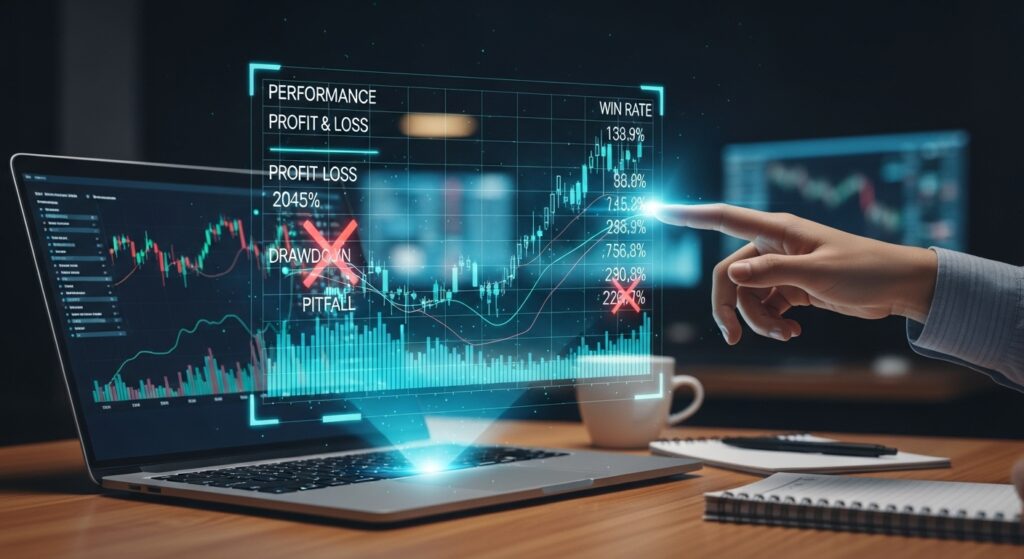
When evaluating any Expert Advisor, start with the fundamental performance metrics that provide insight into both profitability and risk. The profit factor, calculated by dividing gross profits by gross losses, gives you a clear picture of the EA’s overall efficiency. A profit factor above 1.0 indicates profitability, but successful EAs typically show profit factors between 1.3 and 2.5. Extremely high profit factors may indicate over-optimization or unrealistic backtesting conditions.
Maximum drawdown represents one of the most critical risk metrics to examine. This figure shows the largest peak-to-trough decline in account value during the testing period and gives you insight into the worst-case scenario you might experience. Many traders focus exclusively on potential profits while ignoring drawdown, but understanding this metric is crucial for determining appropriate account sizing and psychological preparedness for inevitable losing periods.
The relationship between average winning trades and average losing trades reveals important information about the EA’s trading style and risk profile. Some systems achieve profitability through high win rates with small average wins, while others may have lower win rates but larger average profits per winning trade. Neither approach is inherently superior, but understanding this relationship helps set appropriate expectations and determines whether the EA’s style matches your trading personality.
Recovery factor, calculated by dividing net profit by maximum drawdown, provides insight into how efficiently an EA generates profits relative to the risks it takes. Higher recovery factors indicate more efficient risk-adjusted performance. Similarly, the Sharpe ratio measures risk-adjusted returns by comparing excess returns to volatility, with higher values indicating better risk-adjusted performance.
Backtesting results form the foundation of EA evaluation, but they must be interpreted carefully. Quality backtesting should span multiple years and include various market conditions – trending markets, ranging markets, high volatility periods, and calm trading environments. Be particularly wary of EAs that show exceptional performance over short periods or during specific market conditions, as these results may not be sustainable.
The modeling quality percentage in MetaTrader 4 backtesting results indicates how accurately the test simulated real trading conditions. Results based on “every tick” modeling with 90% or higher quality are generally more reliable than those based on “control points” or lower quality data. However, even high-quality backtesting cannot perfectly replicate real trading conditions, including factors like slippage, requotes, and varying spreads.
Forward testing results, where an EA trades in real-time on a demo account, provide more reliable performance indicators than backtesting alone. This testing phase reveals how the EA performs with live market data, real execution speeds, and actual broker conditions. Many professional traders insist on several months of successful forward testing before risking real money with any Expert Advisor.
Red flags in EA marketing and performance claims should trigger immediate skepticism. Be extremely cautious of EAs claiming guaranteed profits, risk-free trading, or returns that seem too good to be true. Screenshots of trading results can be easily manipulated, and testimonials may be fabricated. Lack of detailed backtesting results, unwillingness to provide forward testing data, or pressure to purchase immediately are all warning signs of potential scams.
The absence of proper risk disclosures or unrealistic marketing claims about win rates should also raise concerns. Legitimate EA developers understand that forex trading involves substantial risk and will provide comprehensive risk warnings and realistic performance expectations. They’ll also offer detailed documentation explaining their trading strategy, recommended settings, and appropriate account requirements.
Best Practices for Successful Expert Advisor Trading
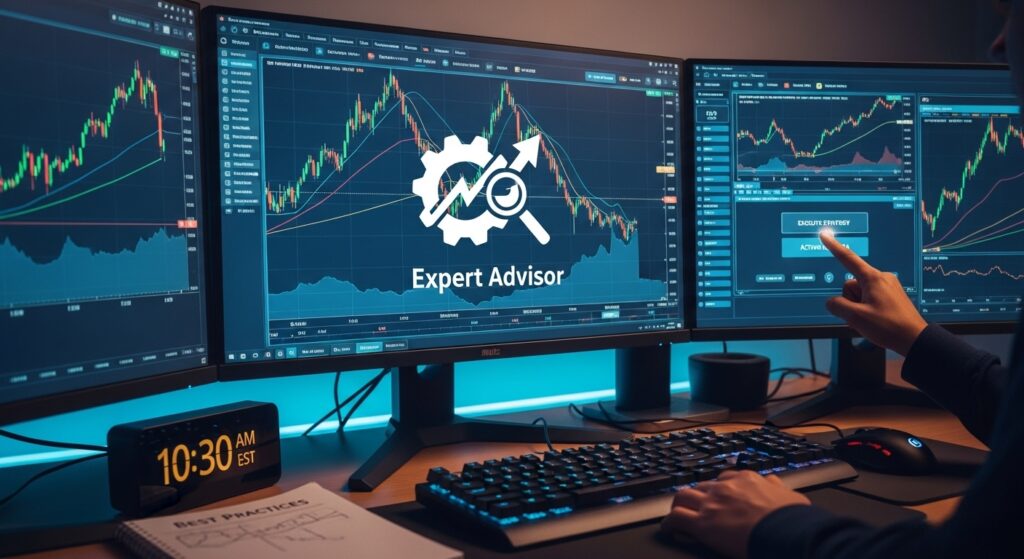
Success with MT4 Expert Advisors requires more than simply installing software and hoping for profits. Developing a systematic approach to EA selection, testing, and management significantly improves your chances of long-term success in automated trading.
The foundation of successful EA trading begins with thorough due diligence before purchasing or implementing any system. Research the developer’s background, track record, and reputation within the trading community. Legitimate developers typically maintain active forums or communities where users discuss results, share experiences, and receive support. Look for developers who are transparent about their methodology, provide detailed documentation, and offer realistic performance expectations.
Diversification plays a crucial role in managing risk when using Expert Advisors. Rather than placing all your capital with a single EA, consider implementing multiple systems with different trading approaches, timeframes, and currency pair focuses. This diversification helps protect against the inevitable periods when any single strategy may underperform due to changing market conditions.
Account sizing and risk management require careful consideration when implementing Expert Advisors. Many EAs are designed and tested using specific account sizes and risk parameters. Using inappropriate lot sizes or risk settings can dramatically alter performance characteristics and potentially lead to account-threatening losses. Start with conservative settings and gradually increase position sizes as you gain confidence in the EA’s performance with your specific broker and market conditions.
The importance of broker selection cannot be overstated when trading with Expert Advisors. Different EAs have varying requirements for spread tolerance, execution speed, and order processing capabilities. Scalping EAs, for example, require brokers with consistently tight spreads and minimal slippage, while longer-term trend-following systems may be less sensitive to these factors. Research broker compatibility and consider testing EAs with multiple brokers to identify optimal trading conditions.
Regular monitoring and performance evaluation should be ongoing processes rather than one-time activities. Even the most successful Expert Advisors may require periodic adjustments to maintain optimal performance as market conditions evolve. Establish regular review periods to analyze performance metrics, compare results to expectations, and identify any concerning trends or changes in behavior.
Parameter optimization presents both opportunities and dangers for EA users. While adjusting settings to better match current market conditions can improve performance, excessive optimization often leads to curve-fitting – tailoring the EA so specifically to past data that it loses effectiveness in future markets. When making parameter adjustments, ensure changes are based on sound reasoning rather than simply trying to improve historical results.
Portfolio management becomes increasingly important as you expand your use of Expert Advisors. Track overall portfolio performance, correlation between different EAs, and total risk exposure across all automated systems. Some traders use portfolio management software or maintain detailed spreadsheets to monitor these factors and ensure their automated trading aligns with overall investment goals.
Staying informed about market conditions and economic events remains important even when using automated systems. While EAs can operate independently, understanding broader market trends, upcoming economic announcements, and potential market-moving events helps you make informed decisions about when to enable or disable specific systems.
Common Mistakes That Can Derail Your Automated Trading Success
The path to successful automated trading is littered with common mistakes that can undermine even the most promising Expert Advisors. Understanding these pitfalls and learning how to avoid them can save you significant time, money, and frustration while improving your chances of long-term success.
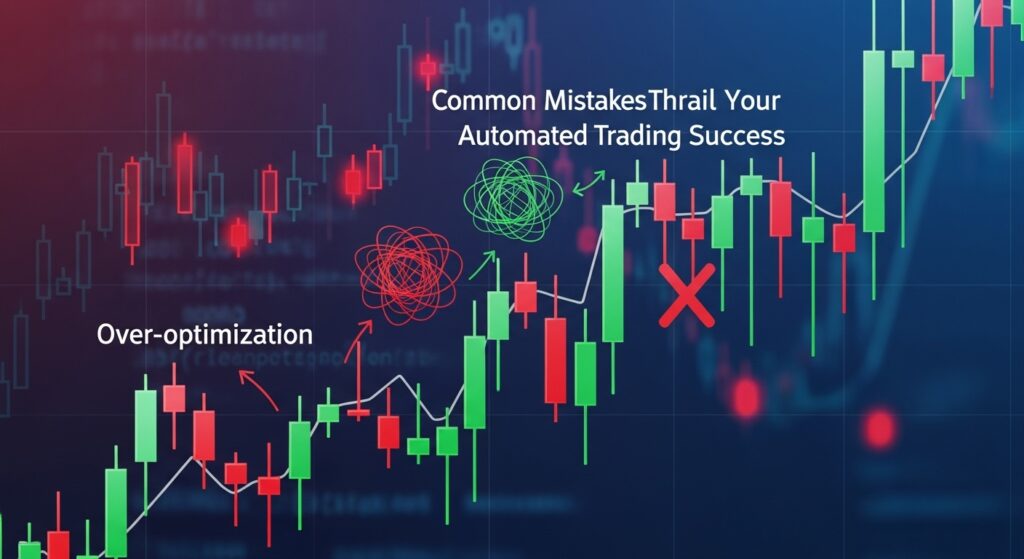
Over-optimization represents one of the most dangerous traps in automated trading. The temptation to continually adjust EA parameters to improve historical performance often leads to curve-fitting – creating systems that work perfectly on past data but fail miserably in live markets. This occurs when traders optimize parameters so specifically to historical price movements that the EA loses its ability to adapt to new market conditions. The key is finding the balance between customization and robustness, focusing on parameters that have logical trading rationale rather than simply improving backtesting results.
Inadequate testing phases represent another critical error that many traders make in their eagerness to start automated trading. Rushing from backtesting directly to live trading without sufficient demo testing or forward validation often leads to disappointing results. Market conditions, broker execution, and real-time data feeds can significantly differ from backtesting environments. Skipping proper testing phases means missing opportunities to identify potential issues with execution speed, slippage impact, or broker-specific compatibility problems.
Unrealistic profit expectations frequently lead to poor decision-making and inappropriate risk-taking. The forex market is inherently risky, and no Expert Advisor can eliminate this fundamental reality. Traders who expect consistent monthly profits or believe they’ve found a “holy grail” system often increase position sizes beyond reasonable levels or ignore warning signs when performance deteriorates. Successful automated trading requires accepting that drawdown periods are inevitable and maintaining realistic expectations based on historical performance data.
Poor risk management practices can quickly destroy trading accounts regardless of how profitable an Expert Advisor might be during favorable conditions. Common mistakes include using fixed lot sizes inappropriate for the account balance, failing to adjust risk parameters as account size changes, or running multiple EAs without considering overall portfolio exposure. Effective risk management involves setting maximum risk per trade, implementing overall account drawdown limits, and regularly reviewing position sizing relative to account growth or decline.
Neglecting broker compatibility factors represents a technical oversight that can significantly impact EA performance. Different brokers offer varying spreads, execution speeds, and order processing capabilities. An EA optimized for ECN execution may struggle with market maker brokers, while scalping systems require extremely competitive trading conditions to remain profitable. Failing to research and test broker compatibility often leads to suboptimal performance that doesn’t reflect the EA’s true potential.
The mistake of running too many Expert Advisors simultaneously without proper coordination can create several problems. Multiple EAs trading the same currency pairs may conflict with each other, creating overexposure or contradictory positions. Additionally, some EAs may not be designed to work alongside other automated systems, leading to unexpected behavior or resource conflicts within the MetaTrader platform.

Ignoring market condition changes represents a strategic oversight that can significantly impact automated trading results. Markets evolve over time, and strategies that worked well during trending periods may struggle during range-bound conditions. Successful automated traders monitor broader market conditions and may temporarily disable certain EAs during unfavorable periods or adjust portfolio allocation based on current market characteristics.
Insufficient capital allocation for automated trading often leads to using excessive leverage or inappropriate position sizes. Many Expert Advisors are designed with specific minimum account requirements in mind, and using them with insufficient capital can dramatically alter their risk-reward profiles. Under-capitalized accounts may experience margin calls during normal drawdown periods that properly funded accounts would weather comfortably.
The Future of Expert Advisors and Automated Trading

The landscape of automated forex trading continues to evolve rapidly, driven by technological advances, changing market structures, and increasing adoption by retail traders. Understanding these trends can help traders position themselves advantageously for the future of Expert Advisor trading.
Artificial intelligence and machine learning integration represent the most significant technological advancement in automated trading. While traditional Expert Advisors follow predetermined rules and parameters, AI-enhanced systems can adapt their strategies based on market conditions, learn from past performance, and potentially identify patterns that human programmers might miss. These advanced systems may incorporate neural networks, genetic algorithms, or reinforcement learning to continuously improve their trading performance.
Cloud-based trading solutions are becoming increasingly prevalent, offering several advantages over traditional desktop-based Expert Advisors. Cloud systems provide superior uptime, faster execution speeds, and the ability to run multiple strategies simultaneously without taxing local computer resources. Virtual Private Server (VPS) solutions specifically designed for forex trading are becoming more affordable and accessible, allowing traders to maintain automated systems with institutional-grade reliability.
The integration of alternative data sources into Expert Advisor decision-making processes represents another frontier in automated trading evolution. Modern EAs may soon incorporate sentiment analysis from social media, satellite imagery for commodity-related currency impacts, or real-time news processing to enhance their market analysis capabilities. These additional data streams could provide trading edges that traditional technical analysis alone cannot achieve.
Regulatory developments continue to shape the automated trading landscape, with different jurisdictions implementing varying requirements for algorithmic trading systems. Some regions are implementing stricter oversight of automated trading, while others are embracing technology-driven approaches to market participation. Staying informed about regulatory changes in your trading jurisdiction is essential for maintaining compliance and understanding potential impacts on EA availability and functionality.
The democratization of sophisticated trading strategies through Expert Advisors is leveling the playing field between retail and institutional traders. Strategies that were once available only to hedge funds and proprietary trading firms are becoming accessible to individual traders through commercially available EAs. This trend is likely to continue, with more advanced institutional-grade strategies becoming available to retail markets.
Platform evolution beyond MetaTrader 4 is also influencing the future of automated trading. While MT4 remains dominant in retail forex, newer platforms offer enhanced capabilities for automated trading, including better backtesting engines, more sophisticated order types, and improved integration with external data sources. The eventual transition of the industry toward more modern platforms may require EA users to adapt their automated trading approaches.
The growing emphasis on risk management and regulatory compliance is driving the development of more sophisticated risk control features in Expert Advisors. Future EAs may include advanced portfolio risk management, real-time correlation monitoring, and automated compliance reporting features to help traders manage risk more effectively and meet regulatory requirements.
Conclusion
The world of MT4 Expert Advisors opens up tremendous opportunities for forex traders seeking to automate their strategies, eliminate emotional decision-making, and potentially improve their trading results. Throughout this comprehensive guide, we’ve explored the fundamental concepts that make Expert Advisors such powerful tools, from their basic functionality and installation procedures to advanced evaluation techniques and best practices for long-term success.
The key to success with Expert Advisors lies not in finding a magical system that guarantees profits, but rather in developing a systematic approach to selection, testing, and implementation. Remember that automated trading is still trading – it carries inherent risks and requires careful risk management, realistic expectations, and ongoing monitoring to achieve sustainable results.
The most successful automated traders understand that Expert Advisors are tools that amplify good trading principles rather than replace them. Sound risk management, diversification, proper capitalization, and realistic expectations remain as important with automated systems as they do with manual trading. The advantage of EAs lies in their ability to execute these principles consistently, without the emotional interference that often derails human traders.
As technology continues to advance and markets evolve, Expert Advisors will undoubtedly become more sophisticated, incorporating artificial intelligence, machine learning, and alternative data sources to enhance their decision-making capabilities. However, the fundamental principles of successful automated trading – thorough testing, appropriate risk management, and realistic expectations – will remain constant.
Whether you’re just beginning to explore automated trading or looking to refine your existing EA strategies, remember that success in this field requires patience, dedication to learning, and a commitment to following proven best practices. The potential rewards of successful automated trading are significant, but they come only to those who approach the field with proper preparation and realistic expectations.
Take the next step in your automated trading journey by starting with demo testing, focusing on education and skill development, and gradually building your experience with Expert Advisors. The future of forex trading increasingly belongs to those who can effectively harness the power of automation while maintaining the wisdom to manage risk appropriately.
Frequently Asked Questions
Are MT4 Expert Advisors legal and safe to use?
Yes, MT4 Expert Advisors are completely legal to use in most jurisdictions, and the MetaTrader 4 platform is specifically designed to support automated trading. However, safety depends on several factors including the EA’s source, your broker’s policies, and your risk management practices. Always download EAs from reputable sources, test thoroughly on demo accounts, and ensure your broker allows automated trading. While the software itself is safe, remember that all forex trading carries inherent financial risk, and no EA can eliminate the possibility of losses.
How much money do I need to start using Expert Advisors effectively?
The minimum capital requirement varies significantly depending on the specific Expert Advisor and your risk tolerance. Many EAs can technically operate on accounts as small as $100-$500, but for optimal performance and proper risk management, most professionals recommend starting with at least $1,000-$5,000. Smaller accounts may force you to use excessive leverage or inadequate position sizing, which can lead to account-threatening risks. Consider that you’ll also need enough capital to weather inevitable drawdown periods while maintaining appropriate position sizes.
Can Expert Advisors guarantee profits or eliminate trading risks?
Absolutely not. No Expert Advisor, regardless of its sophistication or marketing claims, can guarantee profits or eliminate the inherent risks of forex trading. The forex market is inherently unpredictable, and even the most successful EAs experience losing periods and drawdowns. Be extremely wary of any EA marketed with promises of guaranteed returns, risk-free trading, or “holy grail” claims. Successful automated trading requires realistic expectations, proper risk management, and understanding that losses are an inevitable part of trading.
What’s the difference between free and paid Expert Advisors?
Free Expert Advisors, often available through MQL4 community forums, can be excellent learning tools and some are genuinely profitable. However, they may lack comprehensive documentation, customer support, and regular updates. Paid EAs typically offer more sophisticated strategies, better risk management features, ongoing support, and regular updates to adapt to changing market conditions. The price doesn’t guarantee quality, but commercial EAs often undergo more rigorous testing and development. Start with free EAs to learn the basics, then consider paid options as you gain experience and identify specific strategy requirements.
How do I know if my Expert Advisor is working properly?
Monitor several key indicators to ensure your EA is functioning correctly. First, check that the “Auto Trading” button in MT4 is enabled and shows a green light. Verify that the EA appears in the upper right corner of your chart with a smiley face icon, indicating it’s active and running without errors. Review the Experts tab in the Terminal window for any error messages or warnings. Most importantly, monitor the EA’s trading activity and compare its performance to backtesting results and forward testing expectations. Regular performance reviews help identify any unusual behavior or declining effectiveness that may require attention.




